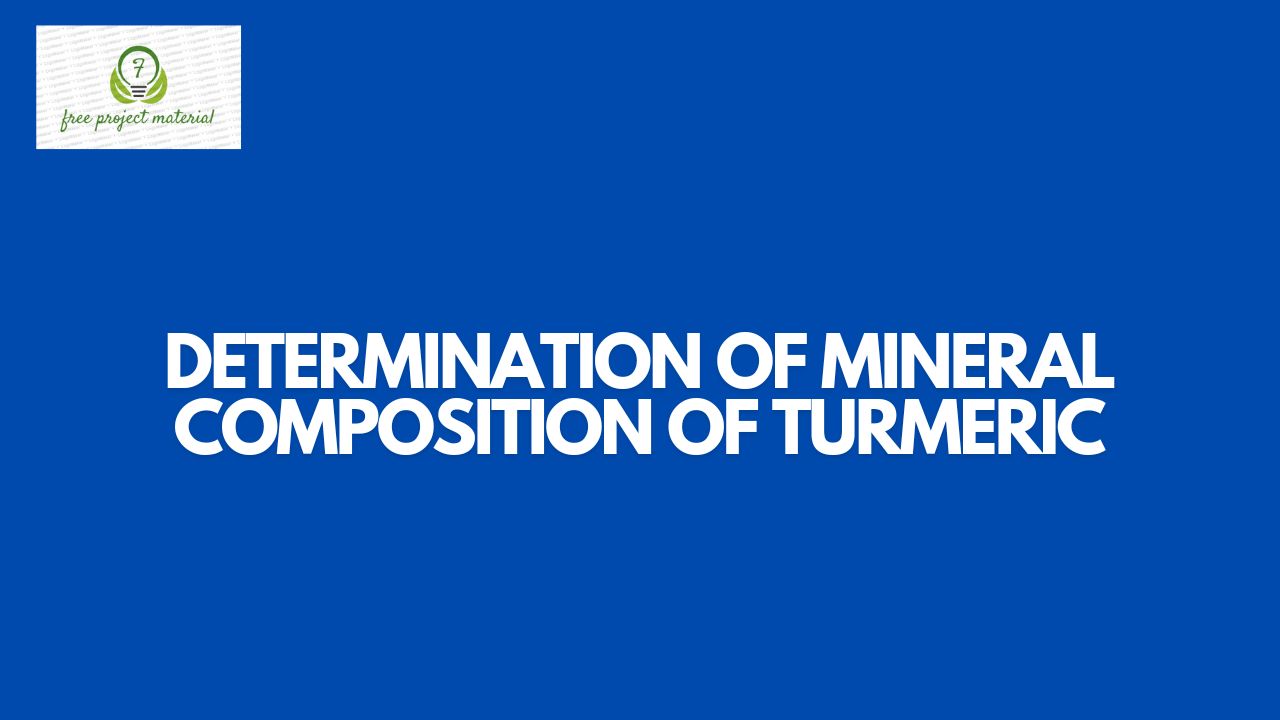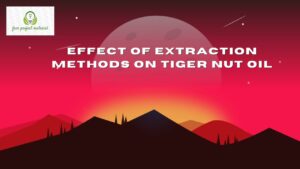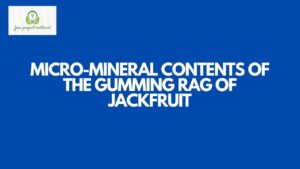ABSTRACT
The analysis of mineral composition in Turmeric (Curcuma longa) found within Ikot Ekpene Local Government Area was carried out using standard analytical method. The result of the analysis (mg/100ml) showed the K. 84.765 ± 0.52 0.51618, Na 67.55± 6.29323; Mg 15.015 ± 0.2757; Cu 2.295± 0.33234. The mean value of the parameters of Curcuma longa. Turmeric is a fruit, highly demanded in the southwest of Nigeria. The results from this study demonstrated the need for the consumption of Turmeric.
TABLE OF CONTENT
Title Page – – – – – – – –
Certification – – – – – – – –
Dedication – – – – – – – –
Acknowledgement – – – – – –
Abstract – – – – – – – –
Table of content – – – – – – –
CHAPTER ONE : INTRODUCTION
1.1Background of the study – – – – –
1.2 Aim and Objectives of the Study – – – –
1.3 Scope and Limitation of the Study – – – –
CHAPTER TWO: LITERATURE REVIEW
2.0 Literature Review – – – – – –
2.1 Desertion – – – – – – –
2.2 Taxonomy- – – – – – – –
2.3 Phytoconstituent of turmeric – – – –
2.4 Phytopharmacology of turmeric – – – – –
2.4.1 Antioxidant activity – – – – – –
2.4.2 Cardiovascular and Anti-diabetics effects – – –
2.4.3 Inflammatory and edematic disorders – – – –
2.4.4 Gastrointestinal effects – – – – – –
2.5.5 Anti-Cancter effect – – – – – –
2.4.6 Antimicrobial activity – – – – – –
2.4.7 Hepatoprotective and renoprotective effects of turmeric –
2.4.8 Alzheimer and turmeric – – – – – –
2.4.9 Photo- protector activity – – – – – –
2.5 Mineral elements – – – – – – –
2.5.1 Calcium – – – – – – – –
2.5.2 phosphorus – – – – – – – –
2.5.3 sodium – – – – – – – –
2.5.4 Potassium – – – – – – – –
2.5.5 magnesium – – – – – – – –
2.4 Micro-Minerals – – – – – – –
2.4.1 Chlorine – – – – – – – –
2.4.2 Chromium – – – – – – – –
2.4.3 Copper – – – – – – – –
2.4.4 Mangnese – – – – – – – –
2.4.5 Zinc – – – – – – – – –
CHAPTER THREE: MATERIALS AND METHOD
3.1 Materials – – – – – – – –
3.2 method – – – – – – – – –
3.2.1 Sample Collection and Prearation – – – –
3.2.2 Sample Digestion – – – – – – –
3.2.3 Determination of mineral Content – – – –
CHAPTER FOUR ; RESULTS AND DISCUSSION
4.1 Results – – – – – – – – –
4.2 Discussion – – – – – – – –
CHAPTER FIVE: COLLUSION AND RECOMMENDATION
5.1 Conclusion – – – – – – – –
5.2 Recommendation – – – – – – –
References
CHAPTER ONE: INTRODUCTION
1.1 Background of the Study
Curcuma longa (Linn.), commonly known as turmeric, is a tropical perennial monocotyledonous herbaceous plant of South and South-eastern Asia (Nwaekpe et al., 2015). It belongs to the family of Zingiberaceae (Jilani et al., 2012). The plant is found primarily grown in tropical regions of Bangladesh, China, Thailand, Cambodia, Malaysia, Indonesia, Philippines and Nigeria. It grows to about 2 feet in length with a broad pulpy, orange leaves. Its rhizome is pungent, bitter and widely used in folk medicine and household remedies for the treatmet of diabetes, high cholesterolemic, abdominal pains, menstrual disorder, wounds, eczema, jaundice, inflammations, cancerous symptoms and as a blood purifier (Sawant and Godghate, 2013).
Minerals are naturally occurring chemical compound, usually of crystalline form and biogenic in origin. A mineral has one specific chemical composition, whereas rock can be an aggregate of different minerals or mineraloids, there are over 5,300 known mineral species. In March 2017, over 5230 of these have been approved by International Mineralogical Association (IMA). Turmeric contains minerals such as Calcium, Potassium, Phosphorus, Iron, Magnesium, Manganese, and Zinc. Minerals are inorganic substances present in the body tissues and fluids and their present is necessary for the maintenance of certain phytochemical processes which are essential to life. Minerals are chemical constituents used by the body in many ways. They have important roles to play in many activities in the body. Every form of living matters requires these inorganic elements or minerals for their normal life processes.
1.2 Aim and Objectives of the Study
The aim of this research project is to determine the mineral elements in Curcuma longa (turmeric).
The objectives were:
- To digest the plant material using appropriate solvents
- To determine the mineral element (copper, iron, zinc, manganese and sodium) content of Curcuma longa (turmeric).
1.3 Scope and Limitations of the Study
The design of the research project is to investigate and determine the mineral elements composition in Curcuma longa (turmeric). The work is limited to the determination of the elemental composition of Curcuma longa.



